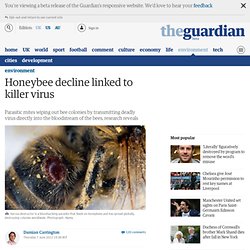

Bees’ Decline Linked to Pesticides, Studies Find. Soaring Bee Deaths in 2012 Sound Alarm on Malady. Honeybee decline linked to killer virus. The deadly link between the worldwide collapse of honeybee colonies and a bloodsucking parasite has been revealed by scientists.

They have discovered that the mite has massively and permanently increased the global prevalence of a fatal bee virus. The varroa mite's role means the virus is now one of the "most widely distributed and contagious insect viruses on the planet", the researchers warned. Furthermore, the new dominance of the killer virus poses an ongoing threat to colonies even after beekeepers have eradicated the mites from hives.
Varroa destructor has spread from Asia across the entire world over the past 50 years. It arrived in the UK in 1990 and has been implicated in the halving of bee numbers since then, alongside other factors including the destruction of flowery habitats in which bees feed and the widespread use of pesticides on crops. Honeybee problem nearing a ‘critical point’ Photo: Pesticide Action Network North AmericaAnyone who’s been stung by a bee knows they can inflict an outsized pain for such tiny insects.

It makes a strange kind of sense, then, that their demise would create an outsized problem for the food system by placing the more than 70 crops they pollinate — from almonds to apples to blueberries — in peril. Although news about Colony Collapse Disorder (CCD) has died down, commercial beekeepers have seen average population losses of about 30 percent each year since 2006, said Paul Towers, of the Pesticide Action Network.